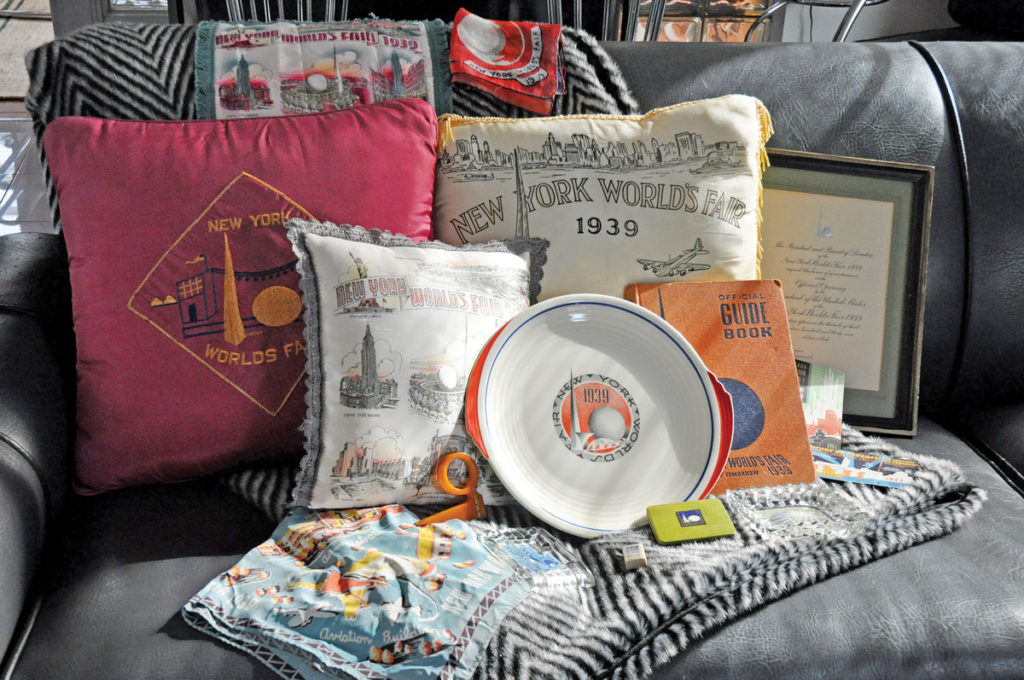80-year-old sugar cube
5/1/2019A lifetime of fun finds adorn Sheree Clark’s Beaverdale home.

WWII began in 1939. Franklin Roosevelt was president. Nuclear weapons had not yet been invented. The average cost of a new home was $3,800. A gallon of gas cost a dime, a loaf of bread went for 8 cents, and the average cost of a new car was $700. “Gone with the Wind” and “The Wizard of Oz” wowed movie-going audiences for the first time. And the 1939 World’s Fair opened in Flushing Meadows, New York.
Sheree Clark wasn’t at the event — she wasn’t born yet — but an impressive collection of ’39 Fair memorabilia is on prominent display within her Beaverdale abode.
“I collect things from the 1939’s World’s Fair,” she says.
The World’s Fair isn’t what it once was eight decades ago. Back then, if you wanted to learn anything about what was cutting edge, the fair was the best way. The spectacle spanned 1,200 acres, and with a theme of “The World of Tomorrow,” the extravaganza offered a peek into the future.
Color photographs were seen by the masses for the first time at the fair, as was the first fax machine, air conditioning and nylon pantyhose.
“The first robot was introduced at the 1939 World’s Fair,” says Clark. “He was this huge square-headed thing, and he had a dog.”
Elektro was the 7-foot cyborg’s name. It was designed by Westinghouse and boasted a 700-word vocabulary voiced by way of a record player built into its chest. Elektro walked, talked, smoked cigarettes, and reportedly talked trash, too, saying, “My brain is bigger than yours.”
Other fair novelties included a display of cards made of human scalps, and visitors had the opportunity to ascend within a building by way of an “electric stairway” — now known as an escalator.
More than 200,000 attended the opening day in 1939, and an estimated 44 million people strolled through the fair’s gates at some point during its duration.
Clark doesn’t have Elektro, or an escalator, or any human scalps, but she does have something that is quite rare. In 1939, instead of eateries stocking tables with sugar packets, as cafes do now, sugar cubes were used instead. And she proudly displays an unopened, neatly wrapped, 80-year-old sugar cube that was given out at the fair.
Clark also has an entire shelf dedicated to items from New York in 1939, including a makeup compact, a Bible, posters and a cigarette case, just to name a few.
Besides the 1939 fair items, Clark has a plethora of other collectables, too.
“My whole house, everything in here is vintage,” she says. “I even have a rotary dial phone.” The relic from the 1930s or 1940s is great for authoritatively hanging up on people, when the situation demands it.
“It’s almost like it was destined for this stuff to find its way to me,” she says. “I feel like I’m the custodian or the caretaker for it.”
Clark isn’t in the hobby for the money. She rarely sells items. Her collection is in use around her home. The antique cameras work, the old-school radio plays, and the furniture is functional.
“I’ve been doing this for 30 years,” she says. “It started in the 1980s. I was in my 20s, and you don’t have a lot of money to spend on things. I didn’t want to spend a bunch of money on cheap furniture and keep replacing it. Antiques just seemed like they would hold their value, and they’re more interesting. What happens over time is that you start realizing this is unique, and other people think it’s cool, and that reinforces it. Then it becomes its own thing.”
Martini and cocktail shakers, one-of-kind jewelry, handbags from the 1960s, a hexagonal display case and a multitude of items salvaged from San Francisco or that arrived via New York City.
“It’s my stuff,” she says. ♦



















